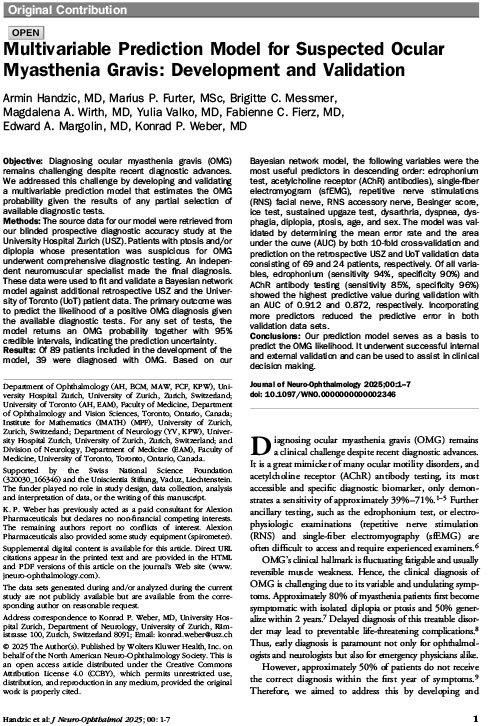Multivariable Prediction Model for Suspected Ocular Myasthenia Gravis: Development and Validation
Apr-25
Abstract
Objective:
Diagnosing ocular myasthenia gravis (OMG) remains challenging despite recent diagnostic advances. We addressed this challenge by developing and validating a multivariable prediction model that estimates the OMG probability given the results of any partial selection of available diagnostic tests.
Methods:
The source data for our model were retrieved from our blinded prospective diagnostic accuracy study at the University Hospital Zurich (USZ). Patients with ptosis and/or diplopia whose presentation was suspicious for OMG underwent comprehensive diagnostic testing. An independent neuromuscular specialist made the final diagnosis. These data were used to fit and validate a Bayesian network model against additional retrospective USZ and the University of Toronto (UoT) patient data. The primary outcome was to predict the likelihood of a positive OMG diagnosis given the available diagnostic tests. For any set of tests, the model returns an OMG probability together with 95% credible intervals, indicating the prediction uncertainty.
Results:
Of 89 patients included in the development of the model, 39 were diagnosed with OMG. Based on our Bayesian network model, the following variables were the most useful predictors in descending order: edrophonium test, acetylcholine receptor (AChR) antibodies), single-fiber electromyogram (sfEMG), repetitive nerve stimulations (RNS) facial nerve, RNS accessory nerve, Besinger score, ice test, sustained upgaze test, dysarthria, dyspnea, dysphagia, diplopia, ptosis, age, and sex. The model was validated by determining the mean error rate and the area under the curve (AUC) by both 10-fold cross-validation and prediction on the retrospective USZ and UoT validation data consisting of 69 and 24 patients, respectively. Of all variables, edrophonium (sensitivity 94%, specificity 90%) and AChR antibody testing (sensitivity 85%, specificity 96%) showed the highest predictive value during validation with an AUC of 0.912 and 0.872, respectively. Incorporating more predictors reduced the predictive error in both validation data sets.
Conclusions:
Our prediction model serves as a basis to predict the OMG likelihood. It underwent successful internal and external validation and can be used to assist in clinical decision making.

